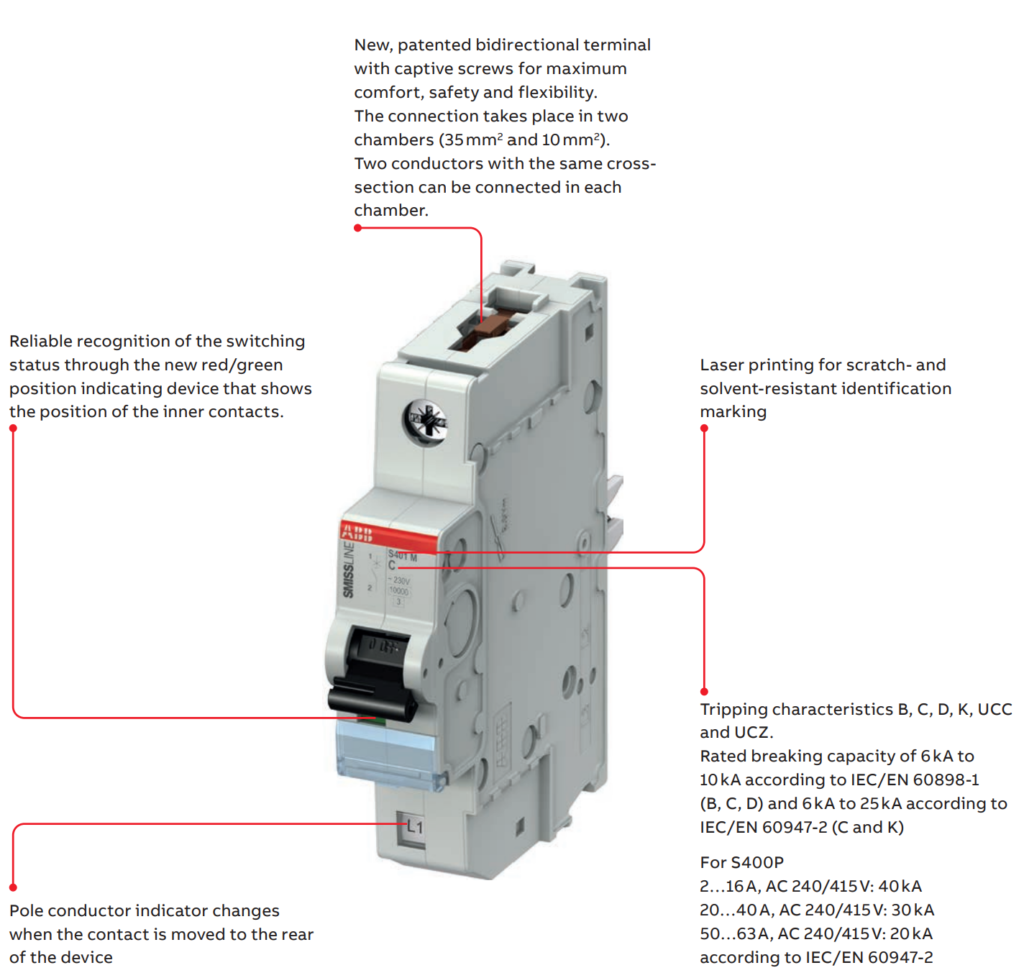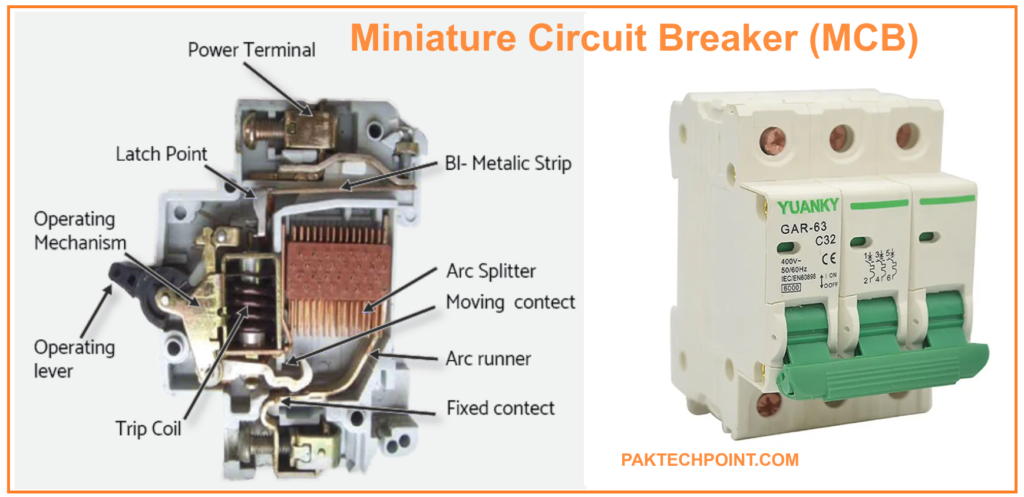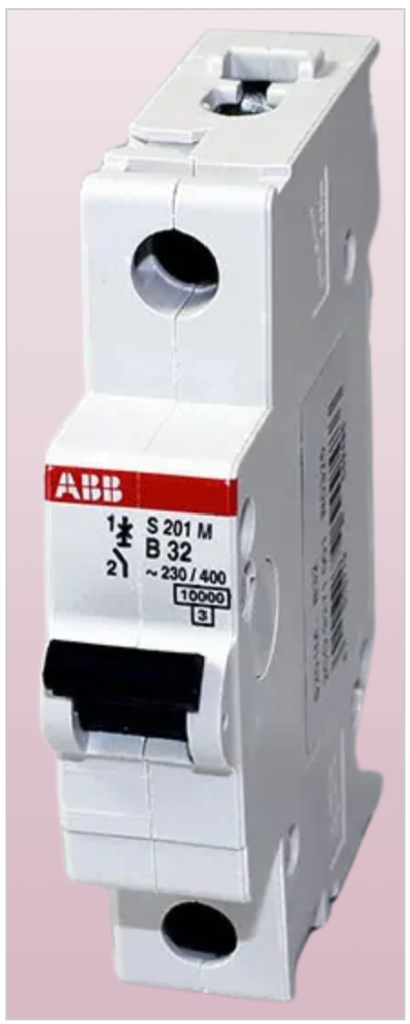A Miniature Circuit Breaker (MCB) is an automatically operated electrical switch designed to protect an electrical circuit from damage caused by excess current resulting from an overload or short circuit. Its basic function is to detect a fault condition and interrupt the current flow, ensuring the safety of the electrical system and preventing damage to equipment and fire hazards.

Working Principle of MCB
The working principle of an MCB involves two main mechanisms: the thermal mechanism for overloads and the magnetic mechanism for short circuits. The thermal mechanism utilizes a bimetallic strip heated by the current, causing it to bend and release a trip latch when overheating occurs. The magnetic mechanism operates when a sudden surge in current (short circuit) induces a magnetic field strong enough to attract a moving iron piece, activating the trip latch.
Under standard conditions, an MCB functions like a manual switch, allowing us to turn a circuit ON or OFF. It automatically trips or activates under overload or short-circuit conditions, interrupting the current flow in the circuit.
This trip is visibly indicated by the automatic movement of the operating knob to the OFF position. An MCB can auto-trip due to two integrated features: magnetic tripping and thermal tripping.

Thermal Tripping:
When overload occurs, the current flowing through the bimetal heats it up. This self-generated heat causes the bimetal to bend due to the thermal expansion of metals, releasing the trip latch and separating the contacts. Some MCBs employ the magnetic field generated by the coil to enhance bimetal deflection, initiating the tripping mechanism.
Magnetic Tripping:
This comes into play under short-circuit or significant overload conditions. Typically, a slug is held in place by a light spring as the coil’s magnetic field is not powerful enough to impact the latch under normal conditions. However, during a fault current, the enhanced magnetic field overcomes the spring force, moving the slug to actuate the tripping mechanism.
Combined Mechanism:
Most MCBs combine both magnetic and thermal tripping mechanisms for enhanced protection. When these mechanisms operate, an arc forms as the contacts separate. This arc is then directed into arc splitter plates or arc chutes, fragmenting the arc and simultaneously extracting and cooling the energy, achieving arc extinction.
In simpler terms, an MCB acts as a guardian to a circuit, monitoring and responding to any irregularities in current flow, thereby ensuring the safety of the overall electrical system.
Construction of MCB
An MCB, or Miniature Circuit Breaker, is housed within a molded insulating material, creating a mechanically strong and insulated enclosure. Here’s a simple breakdown of its construction:

1. Switching System:
- Components: Consists of a fixed and a moving contact, connected to incoming and outgoing wires.
- Material: The contacts are made of electrolytic copper or silver alloy, chosen based on the breaker’s rating.
2. Arc Interruption Process:
- Arc Formation: When contacts separate due to overload or short circuit, an electric arc forms.
- Arc Handling: Modern MCBs have metallic arc splitter plates to handle and cool the arc, supported by an insulating material, and an arc runner directs the arc produced between the main contacts.
3. Operating Mechanism:
- Magnetic Tripping: Comprises a composite magnetic system with a spring-loaded dashpot, magnetic slug, and a current-carrying coil. In events like short circuits, the strong magnetic field attracts the armature of the trip lever, initiating the tripping process.
- Thermal Tripping: Uses a bimetallic strip and a heater coil. The bimetallic strip, usually made of brass and steel, is designed to bend and trip the latch under overload conditions, providing a specific time delay.
Features of MCB
- Automatic Operation: MCBs operate automatically and require no manual intervention to function once they are installed.
- Reusability: Unlike fuses, which must be replaced once they operate, MCBs can be reset and reused.
- High Sensitivity: MCBs are very sensitive to changes in current flow, enabling quick detection of overloads and short circuits.
- Compact Design: MCBs are compact, requiring less space compared to other protective devices like fuses.
- Isolation Feature: They provide a manual means of energizing and de-energizing a circuit, aiding in isolation of circuits for maintenance.
Types of Miniature Circuit Breakers (MCBs)
MCBs come in different types, each designed to meet specific requirements. The primary classification of MCBs is based on their instantaneous tripping currents, and they fall into three major categories:
1. Type B MCB:
- Trip Instantaneously at: Three to five times its rated current.
- Usage: Suitable for places where switching surges are minimal, like residential areas or light commercial installations. They are ideal for resistive or minor inductive loads.
- Application Example: Homes and small offices.

2. Type C MCB:
- Trip Instantaneously at: Five to ten times its rated current.
- Usage: Preferred for high inductive loads, where switching surges are significant, such as circuits with small electric motors and fluorescent lighting.
- Application Example: Commercial and industrial installations with higher inductive loads.

3. Type D MCB:
- Trip Instantaneously at: Ten to twenty-five times its rated current.
- Usage: Appropriate for very high inductive loads, where high inrush currents occur frequently.
- Application Example: Industrial units with large winding motors, x-ray machines, UPS systems, and industrial welding equipment.

All three types of MCBs act quickly, providing protection within one-tenth of a second. They are designed to cater to various levels of loads and surges, ensuring the safety of the circuit and connected appliances.

In addition to tripping current types, MCBs can also be distinguished by the number of poles they possess, such as single-pole, double-pole, triple-pole, and four-pole MCBs, broadening the range of their application in different electrical circuit configurations.
Types of MCBs Based on the Number of Poles
MCBs are also classified based on the number of poles, which denote the number of phases they can control:
- Single Pole (SP): Protects one phase of the circuit, usually used in residential applications.
- Double Pole (DP): Offers protection for two phases, commonly used for 230V circuits in residential applications.
- Triple Pole (TP): Designed for three-phase circuits, primarily used in industrial applications.
- Four Pole: Offers protection for three phases plus neutral in a four-wire system.
Types of MCB Amp Ratings
MCB ampere ratings refer to the maximum current that an MCB can carry without tripping:
- 6A, 10A, and 16A: Suitable for lighting circuits.
- 20A, 32A, 40A, and 63A: Typically used for power circuits, heating loads, and small appliances.
- 80A, 100A, and 125A: Used for high power appliances and industrial machines.
MCB vs Fuse
While both MCBs and fuses serve to protect electrical circuits, they differ significantly in their operation and features:
- Operation: MCBs are automatically operated switches, while fuses are sacrificial devices that must melt to interrupt the circuit.
- Reusability: MCBs are reusable and can be reset after a trip, whereas fuses must be replaced once blown.
- Speed: MCBs can operate faster and are more sensitive to overcurrent than fuses.
- Convenience: MCBs provide more convenience due to their reset ability and clear indication of tripped position, unlike fuses which require inspection to determine if they are blown.
Selection Procedure
When selecting an MCB, considerations should be made for:
- Current Rating: It should be suitable for the maximum current expected in the circuit.
- Short Circuit Breaking Capacity: It must be high enough for the circuit in which the MCB is used.
- Trip Curve: It should be chosen according to the nature of the load and the application.
- Number of Poles: Depending on whether the application is single-phase or three-phase.
How to Select the Appropriate MCB for Diverse Loads?
Selecting the right Miniature Circuit Breaker (MCB) is crucial to ensure steadfast protection against overloads and short circuits. An improper choice can lead to unwanted tripping and inefficiencies in circuit protection. Understanding the differences between MCB, MCCB, ELCB, and RCB, RCD, or RCCB Circuit Breakers, and comprehending MCB Nameplate data are pivotal before diving into the selection process.
The Challenges of Incorrect Sizing:
- Undersized MCBs: If an MCB is rated less than the nominal load current, it may trip frequently, disrupting the current flow to the connected load. This is because the nominal current of the MCB is lower than the load’s nominal current value.
- Oversized MCBs: Conversely, if an MCB is rated higher than the nominal load current, it may not provide efficient protection, and the load may draw overcurrent without the MCB tripping.
Considerations for Proper MCB Selection:
When choosing an MCB for a specific application, it is crucial to consider the following factors:
- Nominal Rating of the Circuit Breaker:
- The nominal rating of the MCB should be carefully considered. It is the rated ampere current rating of MCB and should ideally be higher than or equal to the maximum full load current but lower than the current-carrying capacity of the wiring system.
- Generally, it is wise to choose an MCB that can handle 125% of the continuous load plus the rating of the non-continuous load. It is expressed as: Maximum full load current in the system≤Current rating of MCB≤Cable ratingMaximum full load current in the system≤Current rating of MCB≤Cable rating
- kA Rating or Breaking Capacity:
- This is a representation of the MCB’s ability to interrupt the circuit under short-circuit conditions and is expressed in Kilo Amps (KA).
- The breaking capacity should not be less than the prospective short-circuit current, the maximum current possible during short-circuit conditions.
- For residential installations, a 6KA MCB is generally adequate, while commercial and light industrial applications might require 10 KA or above.
- Type of MCB:
- The selection of MCB type is influenced by the desired operating characteristics and the need to accommodate various current ratings to operate the loads instantaneously.
- Understanding different types of MCBs and their applications is essential for making an informed decision, as previously discussed.
MCB Applications
MCBs are indispensable in modern electrical installations, used in:
- Residential Buildings: Protecting lighting and power circuits.
- Commercial Premises: Safeguarding equipment and preventing electrical hazards.
- Industrial Applications: Securing machinery and processes against electrical faults.
- Power Distribution Boards: Serving as primary protection devices for sub-circuits.
Miniature Circuit Breakers (MCBs) serve as integral protective components in electrical systems, ensuring the safety and reliability of various electrical installations. The fundamental applications of MCBs are outlined below, focusing on their role in guarding against short circuits, overcurrent, and overloads, which are critical aspects of electrical safety.
Protection Against Short Circuit:
A short circuit is a perilous situation that arises when there is an unintended, low-resistance connection between two points in an electric circuit, leading to a sudden surge in current. This condition can cause significant harm to the components within the circuit and poses a serious fire risk.
- Role of MCB: In the occurrence of a short circuit, the magnetic mechanism of the MCB activates immediately, responding to the abrupt increase in current flow. The MCB swiftly interrupts the circuit, preventing potential damage and mitigating associated risks.
- Application Areas: The protection against short circuits is essential in every electrical installation, ranging from residential settings to expansive industrial plants. It serves to avert extensive damage to wiring systems, household appliances, industrial machinery, and other electrical equipment.
Protection Against Overcurrent:
Overcurrent is an undesirable condition wherein the current traversing through the circuit surpasses its designated capacity. This scenario can occur due to a multitude of reasons, such as a short circuit or an overload, posing a threat to the overall integrity of the electrical system and the equipment connected to it.
- Role of MCB: The MCB is meticulously engineered to detect overcurrent conditions promptly. It acts to interrupt the electric flow instantaneously, thereby safeguarding the circuit and the connected apparatuses from the detrimental effects of overheating and subsequent damage.
- Application Areas: The necessity for overcurrent protection is omnipresent, spanning residential homes, commercial offices, and industrial manufacturing units. It is paramount in shielding diverse devices, including computers, motors, and heating elements, from the adverse impacts of overcurrent, thereby enhancing their operational lifespan and reliability.
Protection Against Overload:
Overload conditions emerge when the electrical current flowing within a circuit exceeds its predetermined capacity for an extended duration. This is usually a consequence of having too many devices or equipment operating concurrently on the same circuit, which can lead to an elevated risk of overheating.
- Role of MCB: In the event of an overload, the MCB employs its thermal mechanism to sense the sustained excess current. This mechanism induces the bending of a bimetallic strip, subsequently causing the breaker to trip and disconnect the overly burdened circuit, preventing potential damage and fire hazards.
- Application Areas: The deployment of MCBs for overload protection is a non-negotiable requirement across various sectors, including residential, commercial, and industrial domains. It is vital for safeguarding diverse circuits and equipment, from lighting circuits and power outlets to sophisticated machinery, ensuring uninterrupted operations and minimizing downtime.
Disadvantages of MCB
While MCBs are essential protective devices, they are not without limitations:
- Sensitivity to Environmental Conditions: MCBs can be sensitive to ambient temperature, which may affect their performance.
- Cost: The initial investment in MCBs is higher compared to fuses.
- Inability to Clear High Fault Currents: Under extreme conditions, some MCBs might fail to interrupt high fault currents.
Miniature Circuit Breaker Symbol:

Conclusion
Miniature Circuit Breakers (MCBs) are pivotal in maintaining the safety of electrical circuits by preventing damage due to overloads and short circuits. Their categorization based on trip curves, pole numbers, and ampere ratings allows for varied applications across residential, commercial, and industrial settings. The selection and application of MCBs require meticulous consideration of their ratings, trip characteristics, and the nature of the load to ensure optimum protection. While their advantages significantly outweigh the disadvantages, acknowledging their limitations is crucial for the effective safeguarding of electrical installations.
FAQs about MCB:
FAQ 1: What is the Role of the Bimetallic Strip in an MCB?
FAQ 2: How Do MCBs Differ in Their Tripping Characteristics?
FAQ 3: Can an MCB Replace a Fuse in a Circuit?
FAQ 4: What is the Significance of the kA Rating of an MCB?
FAQ 5: Is it Necessary to Select an MCB Based on the Number of Poles?
Related Articles: